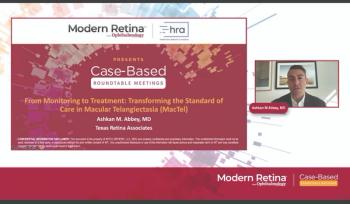Pars plana vitrectomy is the most common surgical procedure performed by retina specialists. Clear visualization plays a crucial role in the success of a vitrectomy procedure, whether it is performed to address complex conditions such as retinal detachment, macular hole, or epiretinal membrane, or to alleviate symptomatic vitreous opacities.
Routine indications for vitrectomy
A slightly different distribution of vitrectomy cases may be encountered in an academic setting than in a private practice setting. In an academic setting, the main indications for vitrectomy are retinal detachments, macular holes, and epiretinal membranes. Other common indications include diabetic vitreous hemorrhages, tractional detachments, and other proliferative diseases.
In contrast, symptomatic vitreous opacity is increasingly becoming a leading indication in some private practice settings, catalyzed by greater patient awareness and a concerted effort to educate referring optometrists on the benefits of vitrectomy for patients whose floaters significantly affect their quality of life. It is not uncommon for private practices to treat several of these patients each week. Careful consideration is central to ensuring they benefit from the procedure to avoid an unnecessary surgery. In our experience, the best candidates for treatment of symptomatic vitreous opacities have pseudophakia, have had stable floaters for at least 6 months, and are not at high risk for retinal detachment.
Achieving optimal visualization
It is essential to ensure that a complete posterior vitreous detachment (PVD) is induced during vitrectomy to decrease the risk of future retinal detachments and other complications. Complete vitreous removal, however, can be challenging. The vitreous is clear, and it is easy to be fooled by the movement of the vitreous in the eye. Therefore, reliable visualization is essential to ensure complete removal, minimize complications, and maximize postoperative outcomes.
Steroid-assisted visualization by staining the posterior hyaloid face, especially at the optic nerve, is a helpful technique to ensure complete and safe removal of the vitreous. It is also a great tool for teaching fellows, who benefit from a visual aid that helps them identify the hyaloid face and properly induce a complete PVD. Additionally, this technique may be used alone or in combination with a vital dye to stain the internal limiting membrane (ILM) or counterstain an epiretinal membrane.
Options for steroid-assisted visualization include off-label use of an injectable corticosteroid not approved for ocular indications, injectable compounded agents, and injectable preservative-free corticosteroids. Of these, an injectable preservative-free corticosteroid is not only our preferred method but also the safest option. Off-label use of a steroid not approved for ocular indications, such as triamcinolone acetonide injectable suspension (Kenalog; Bristol Myers Squibb) or compounded alternatives, raises safety concerns, especially now that a preservative-free corticosteroid is back on the market in the United States.
Alternatively, an intraocular corticosteroid such as preservative-free triamcinolone acetonide injectable suspension 40 mg/mL (Triesence; Harrow) promotes staining and identification of the vitreous and posterior hyaloid face. In clinical studies, the product was shown to effectively enhance visualization of posterior tissues and vitreous during vitrectomy.1
Harrow relaunched Triesence in October 2024 following more than 5 years on the FDA drug shortage list. More recently, the Centers for Medicare & Medicaid Services (CMS) approved expanded reimbursement access across all care settings, including eye care practices, ambulatory surgery centers, and hospital outpatient departments, increasing access to all Medicare beneficiaries.2 Triamcinolone acetonide injectable suspension 40 mg/mL is currently the only FDA-approved, preservative-free corticosteroid indicated for visualization during vitrectomy. It is also indicated in an outpatient setting for uveitis and the treatment of patients with ocular inflammatory conditions that are unresponsive to topical steroids. It is available to health care providers directly through major pharmaceutical wholesale distributors using the J-code J3300.3
Best practices and other alternatives
Diluted vs undiluted techniques
John Kitchens, MD: Precision with dilution
I typically dilute triamcinolone acetonide injectable suspension 40 mg/mL (Triesence; Harrow) in a 4:1 ratio with balanced salt solution for use in vitrectomy, although I know of other surgeons who prefer less dilution. I find the diluted suspension spreads more evenly in the vitreous cavity and allows better visualization without clumping. After dilution, a small-volume injection technique is used to direct a controlled puff over the optic nerve and posterior pole, focusing on areas where posterior hyaloid separation and residual vitreous are most likely. The goal is not to flood the eye but rather to use just enough diluted steroid to highlight structures that could otherwise be missed and avoid clouding the view of the vitreous.
Sumit Sharma, MD: Conservative, undiluted application
I use triamcinolone acetonide injectable suspension 40 mg/mL undiluted but in very small amounts. A light, targeted injection of 1 or 2 puffs is directed over the optic nerve head and macula to highlight the posterior hyaloid. I like to draw preservative-free triamcinolone acetonide up with the vitreous cutter and reflux it into the eye where I feel it is needed to best stain the vitreous, although a needle may also be used. I find a cutter works best with a preservative-free solution to direct the steroid precisely where it is needed. When used carefully, undiluted triamcinolone acetonide provides excellent contrast and surgical control, especially in challenging cases with vitreoschisis or when the view is not clear.
Incorporating triamcinolone acetonide injectable suspension 40 mg/mL into a vitrectomy case is relatively straightforward, but technique and dilution vary by surgeon preference (see Diluted vs undiluted techniques). The key is finding the concentration of the steroid that works best in the surgeon’s hands. We find the best approach is to administer small puffs of either diluted or undiluted triamcinolone acetonide injectable suspension 40 mg/mL precisely at areas where the vitreous needs to be identified.
Whether diluted or undiluted triamcinolone is used to stain the vitreous, the effect is the same: enhanced visualization that enables thorough removal of the vitreous and helps induce a complete PVD. Triamcinolone may also be used to stain epiretinal membranes as a direct visualization aid without using a vital dye to stain the ILM. If too much steroid is inadvertently injected into the eye, the infusion may cause it to disperse too widely, obscuring the view. Our advice is to limit the amount of undiluted intravitreal triamcinolone or consider diluting it with balanced salt solution in a ratio of 1:4 to 1:8.
When preservative-free triamcinolone was not available, many surgeons used preservative-containing Kenalog. Now that a preservative-free option is back on the market, we urge caution with the use of a preservative-containing product. If a preserved formulation is used, it is crucial to ensure it is washed out and completely removed from the eye to reduce the concerns of sterile endophthalmitis and toxic anterior segment syndrome. Other alternatives to stain the vitreous and improve visualization include indocyanine green (ICG) dye and brilliant blue G (BBG) dye, which can also help identify the posterior vitreous face. There are some instances, such as an epiretinal membrane or macular hole, for which it makes sense to combine visualization techniques. In these cases, starting with an intraocular corticosteroid and restaining the area with ICG or BBG dye to stain the ILM can be helpful.
Conclusion
Reliable visualization tools are critical in retina surgery. With preservative-free triamcinolone acetonide available and broadly reimbursed for all Medicare patients and in all care settings, we again have an on-label option directly indicated for visualization of the vitreous during retina surgical procedures.
References
Dyer D, Callanan D, Bochow T, et al. Clinical evaluation of the safety and efficacy of preservative-free triamcinolone (Triesence [triamcinolone acetonide injectable suspension] 40 mg/ml) for visualization during pars plana vitrectomy. Retina. 2009;29(1):38-45. doi:10.1097/IAE.0b013e318188c6e2
John W. Kitchens, MD
jkitchens@gmail.com
Kitchens practices at Retina Associates of Kentucky in Lexington. He speaks both nationally and internationally about new treatments for age-related macular degeneration, diabetes, and vascular disease and is listed among the Ocular Surgery News Retina Top 150 Innovators in Medical Surgical Retina.
Sumit Sharma, MD
sumitsharma.md@gmail.com
Sharma is a retina and uveitis specialist at Cleveland Clinic’s Cole Eye Institute in Ohio and the enterprise vice chair of the Integrated Surgical Institute at the Cleveland Clinic.













































